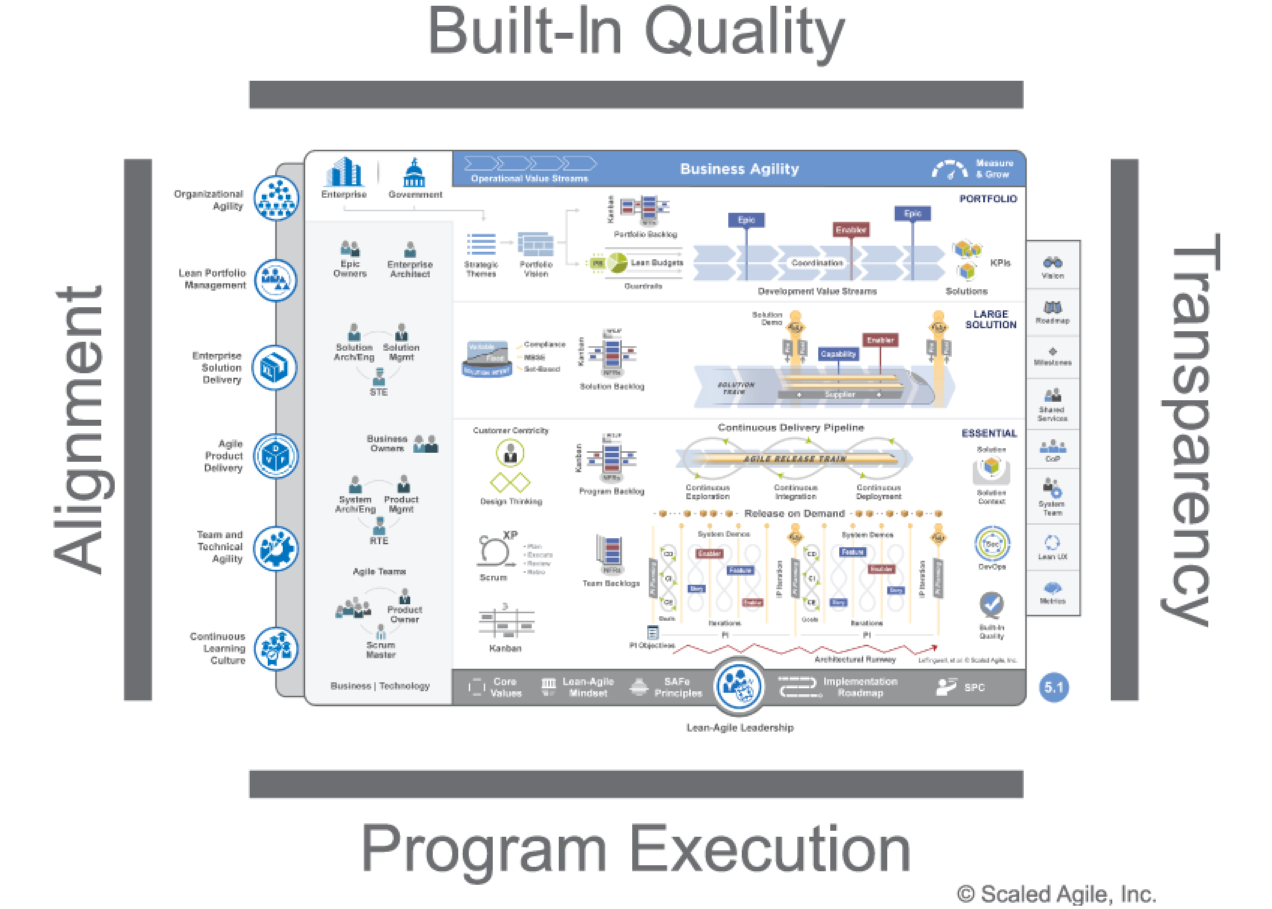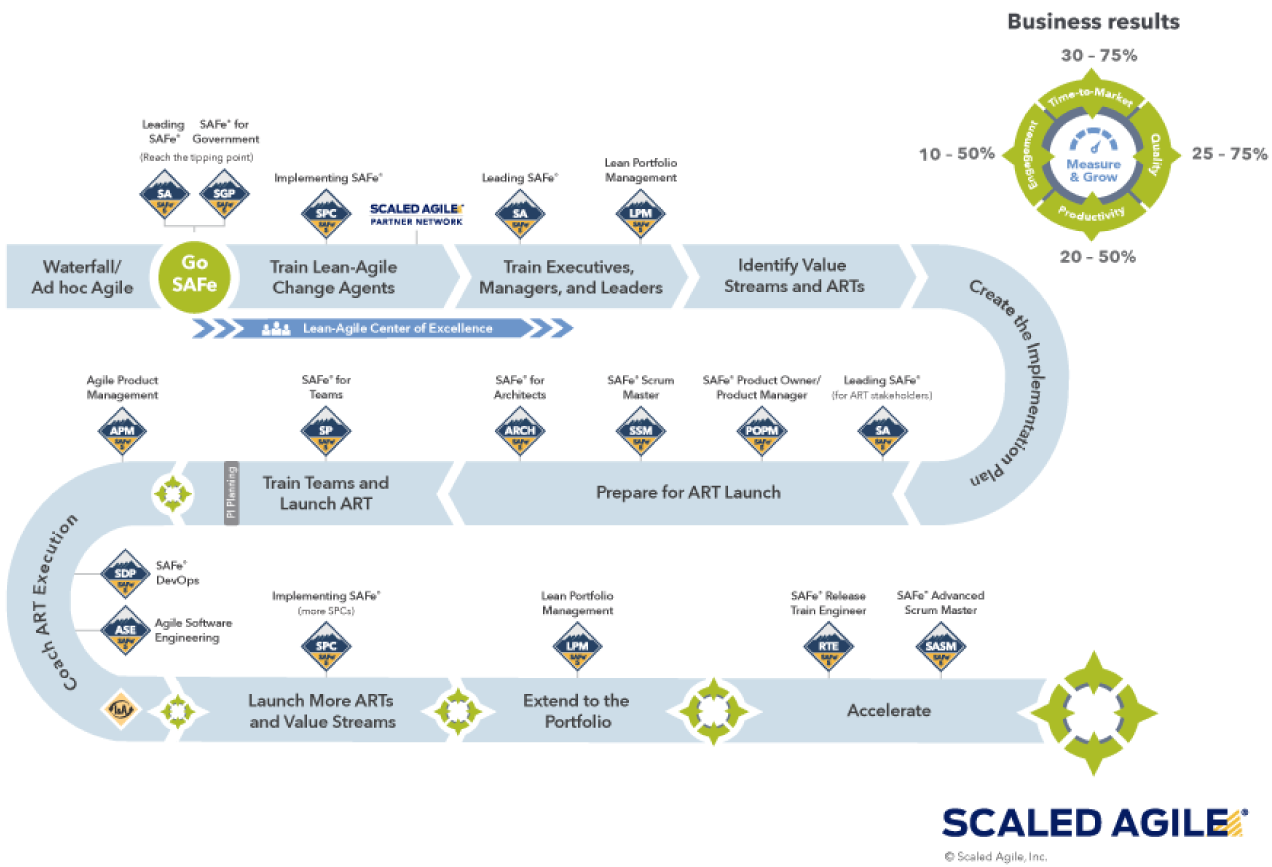What is SAFe (Scaled Agile Framework)
Scaled Agile Framework® (SAFe®) is a rich body of knowledge that provides organizational workflows for Business Agility. SAFe builds on top of team level frameworks like Scrum and XP and integrates Lean patterns into the organization with the objective of Business Agility as opposed to team agility. Business Agility is the ultimate outcome for a business and team agility is a component of the larger picture.
The Agile mindset was codified in 2001 in Snowbird, Utah when some of the greatest thought leaders in software industry got together and created the Agile Manifesto. The Agile Manifesto through its 4 values and 12 principles provided a common language for software developers (as well as others). The industry was quick to lap up the guidance provided by the Agile Manifesto and frameworks like Scrum and XP which provided actionable practices and principles to “implement” the Agile mindset became popular.
As Scrum started to take roots, organizations started to realize that the guidance worked well for small, independent teams. When it comes to large enterprises, it is unlikely that one team can deliver value to the customer directly. There are fundamental issues around the way enterprises are structured and organized which inhibits their agility. Even if such issues are resolved, it would still take several teams to come together to create real customer value. Hence, organizations started to look for a solution on how to “scale” the agile principles and values across the enterprise. Scaled Agile Framework or SAFe was developed as a guidance for solving this problem.
SAFe is built on learnings from Lean Thinking in addition to agile. SAFe relies on mindset shifts on some of the fundamental aspects of an organization. The 4 core values of SAFe are:

SAFe principles guide the thinking process and philosophy behind SAFe’s practices and patterns. There are a total of 10 SAFe Lean Agile Principles. They are based on the principles of the Agile Manifesto as well as learnings from Lean.
Very often people get bogged down by practices without understanding the reason why the practice was created in the first place. As a result, they start feeling “process overhead”.
The 10 Lean Agile Principles of SAFe are
With the 10 Lean Agile Principles of SAFe, we can understand that even if everyone’s problems are unique, the underlying principles of solving them are the same.
SAFe is not a rigid framework. You do not need to implement the framework in its entirety from the very beginning. It provides guidance on how to operate as “Team of Teams” construct through its Essential SAFe configuration. This configuration provides patterns like how to organize around value through agile release trains and how to get to customer centricity through design thinking, apart from DevSecOps and the notion of Develop on Cadence while Releasing on Demand.
The Large Solution SAFe configuration introduces the enterprise solution delivery competency, which supports those building the largest and most complex solutions that require multiple Agile release trains and suppliers, but do not require portfolio-level considerations.
The Portfolio SAFe configuration provides the lean portfolio management competency, which aligns portfolio execution to enterprise strategy. It organizes development around the flow of value through one or more value streams.
The Full SAFe configuration includes all seven core competencies of the Lean enterprise. It is the most comprehensive version of the Framework and supports enterprises that build and maintain a portfolio of large and complex solutions.
Enterprises typically start with Essential SAFe as their first stepping stone into SAFe and gradually implement Portfolio practices.
SAFe has a “troika” of roles at every level. At the team level, the roles are the same as in Scrum – Product Owner, Scrum Master and Developers.
At the Program level, the troika consists of the Product Manager, System Architect and Release Train Engineer(RTE). The Product Manager is a customer facing role and has the content authority on the program backlog while the Product Owner(Team Level) is an internal facing role and has content authority on the team backlog.
The System Architect is the technical authority at the program level and helps in creating the architectural runway. They collaborate closely with the Product Manager to prioritise the program backlog.
The Release Train Engineer is the facilitator and coach for the Agile Release Train. The Release Train Engineer is to an Agile Release Train what a Scrum Master is to a team.
Every Agile Release Train also has a Business Owner who is the key stakeholder to the train. They are the key decision makers and their active participation is critical to the success of the train.
In the case of Large Solution Layers, we have a Solution Architect which is basically the same role as System Architect but at the level of a Solution Train. The Solution Management is a role similar to that of the Product Management but at the level of a Solution Train. The Solution Train Engineer(STE) is to the Solution Train what an RTE is to an Agile Release Train.
At the Portfolio Level, SAFe talks about the Enterprise Architect, which is typically someone like a CTO and can provide technical leadership across value streams. The Epic Owner is someone who shepherds an Epic through Portfolio Kanban and prioritisation process. Once approved, the discovery and execution of Epic becomes the local context of Agile Release Trains through Features(Epics are decomposed into features)
The basic construct in SAFe is a Team of Teams which is referred to as Agile Release Train. An Agile Release Train is not just a random collection of teams. Rather, it is a self-contained “team of teams” which creates value. It is a cross functional “virtual” unit of people who may be a part of different parts of the organisation, hierarchically.
However, they come together as per SAFe Lean Agile Principle #10(Organise Around Value) in a way that they can collaborate fast in a decentralised decision-making arrangement(SAFe principle #9) to create value.
A Value stream may consist of one or more Agile Release Trains. The recommended size of an Agile Release Train is 50-125 people. An Agile Release Train is governed by a single backlog, referred to as “Program Backlog”. The Program Vision and roadmap guides the Agile Release Train.
SAFe has a rich gamut of trainings. It offers courses for teams, for Scrum Masters, for Product Owners, for Architects, for Portfolio Managers amongst others. Most trainings are 2 full day courses with immersive learning experiences.
These courses are highly sought after as they offer a wonderful learning experience as well as provide participants an opportunity to earn an industry recognised certification. SAFe certifications are valid for a year and participants can renew them by paying a renewal fee.
More details about SAFe trainings can be found here.
SAFe’s strength lies in its focus on Business Agility. It focusses on orchestrating an enterprise in its entirety towards a common business goal and suggests workflows and patterns for this purpose.
It is a well thought and researched framework that gets regularly updated as new ideas and concepts emerge in the industry. For this reason, SAFe undergoes regular version updates. The current version of SAFe is 5.1.
The current version talks about seven competencies of Business Agility. These 7 competencies are the pillars which pave the way to a mindset shift which ultimately helps them achieve Business Agility.
Some people consider SAFe as too prescriptive due to the level of details that it provides. For example, they find too many roles in SAFe. Further, some people feel that SAFe complicates the agile transformation by adding “codified bureaucracy”.
In reality, SAFe is more “descriptive” than prescriptive. You may not need to follow it exactly but tailor parts of it as per your need. For example, most organisations start with Essential SAFe configuration as the starting point and then explore Large Solution and Portfolio constructs depending on their maturity.
People need to understand the underlying principles and choose practices and roles accordingly, to succeed with SAFe.
SAFe provides a proven set of activities and steps that must be implemented across an organisation. This includes getting leadership on board through workshops and trainings as they need to understand the concept first.
Value Stream identification workshop is a key activity that helps in identifying the right set of steps in value creation along with the people and processes involved. Post that classes like Leading SAFe, SAFe PO/PM, SAFe Scrum Master, etc are helpful to train the people about their roles and responsibilities. This culminates in the launch of an Agile Release Train. Once an Agile Release Train has been launched, the journey can be accelerated by launching more trains and by extending to the Portfolio by bringing in Lean Portfolio Management practices.
SAFe is a great choice for you if you have at least fifty people in your organisation. It provides a mechanism for several teams to align on value creation. Fifty is suggested as a minimum number to launch an Agile Release Train.
If there are less than 3-4 teams, some of the guidance that SAFe provides could be an overhead and using simple Scrum of Scrums technique might be helpful. However, the principles that SAFe espouses around Lean Portfolio Management are universal in nature and can be used irrespective of the size of the organisation.
In addition to Agile principles, SAFe is heavily rooted in Lean Thinking which helps in reducing waste and focuses on overall Systems Thinking. These concepts can be applied irrespective of the size of the organisation.
Conclusion
In today’s world where enterprises need to be nimble to respond to the changing business and technology landscape, you need a framework which guides you through the journey. Expecting software development to use frameworks like Scrum alone is not sufficient. The enterprise as a whole needs to have a strong footing on agile principles and a mindset shift is required to have Business Agility. Scaled Agile Framework is one such framework which can help enterprises on their journey to Business Agility.
Research & References of What is SAFe (Scaled Agile Framework)|A&C Accounting And Tax Services
Source

